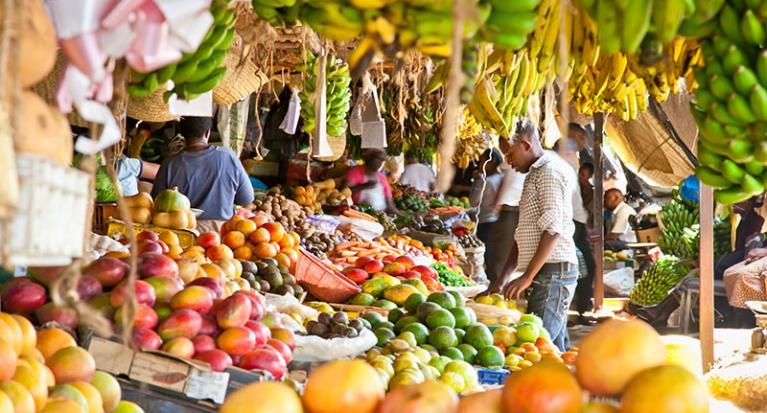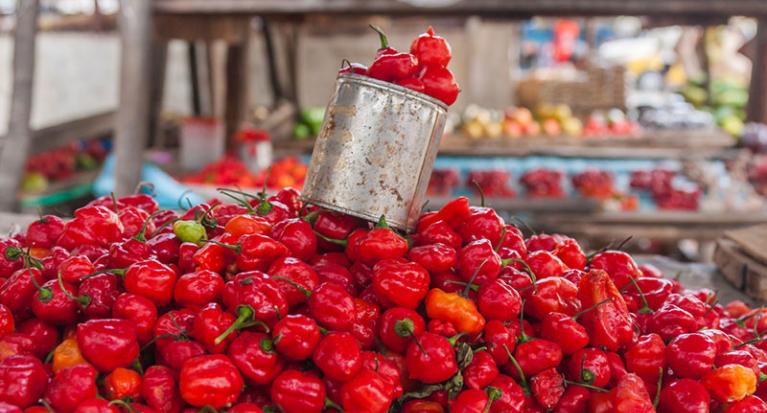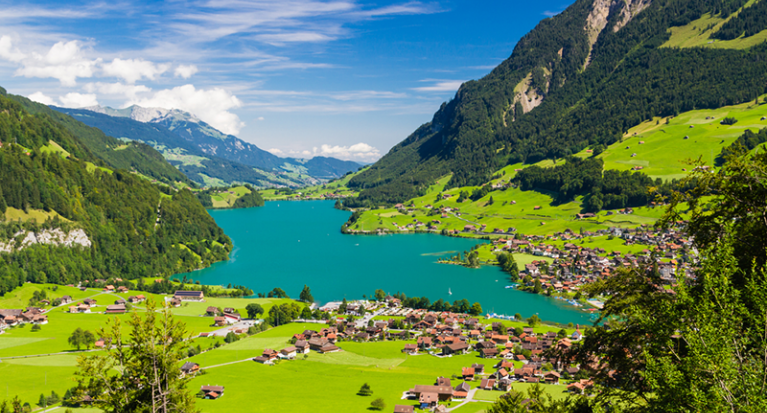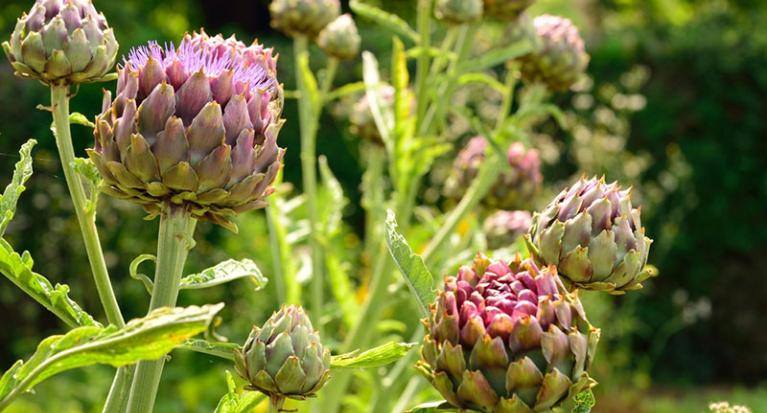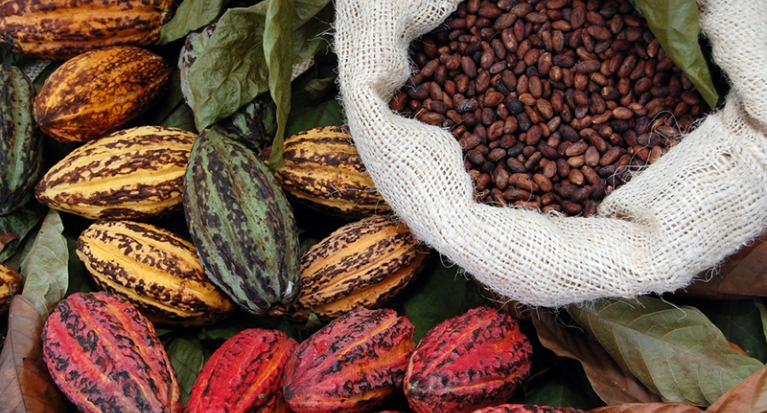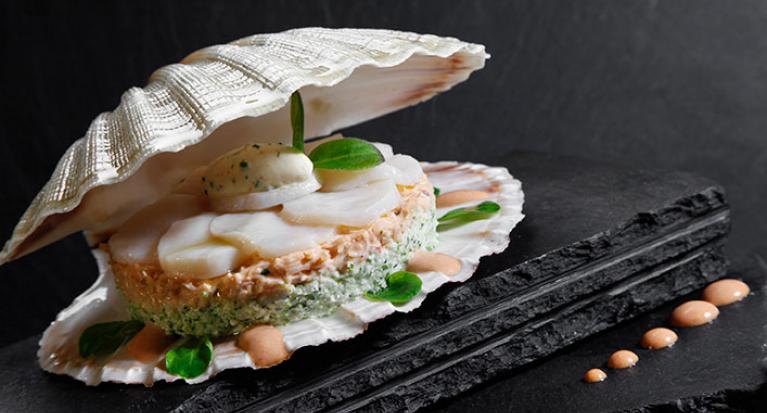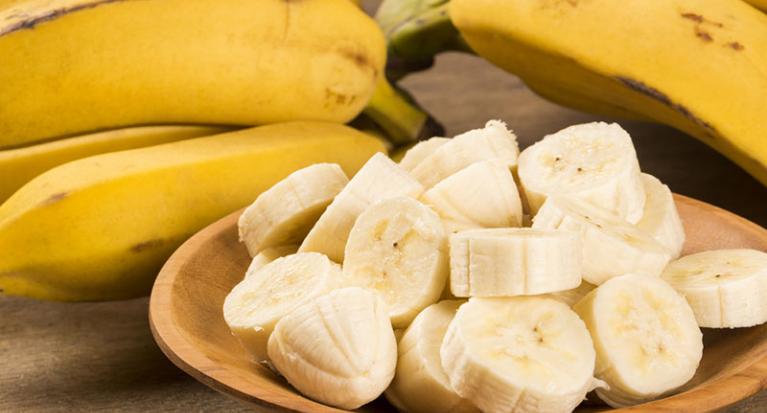The colour of food
Pigments and the nutritional properties of colourful food
A variety of colours in fruit and vegetables.
©Shutterstock/okanakdeniz
The colour of food has quite an impact on our choice of what we eat. We instinctively prefer the colours red, orange and yellow over green and blue, which tend to represent bitterness and oxidization. Man is naturally attracted towards sweet food and dislikes all things bitter, a tendency which is evident right from birth1. However, such preferences are also influenced by our individual experiences and education, cultural norms and tendencies. The colour of a particular foodstuff can also influence our perception of tastes, flavours or odours and we often associate certain colours with particular tastes: pink with sweet things, green with salty food and the colour orange with spicy food2.
In the world of plants, colours come from four main pigments:
- Chlorophyll, in green vegetables
- Carotenoids (β-carotene, lutein, zeaxanthin, lycopene) making carrots orange and tomatoes red
- Anthocyanins (cyanidin, delphinidin, malvidin) responsible for the red, purple, blue and even black colour of radishes, aubergines, artichokes, grapes, black rice and blackberries
- Flavonols (querectin, myricetin, kaempferol) giving many kinds of fruit and vegetables their yellow hue
White fruit and vegetables, such as fennel, garlic and onions, lack any pigment, but this does not affect their nutritional properties. All pigments deteriorate once fruit or vegetables have been harvested or when they are cooked, thus speeding up the natural chemical and climatic transformation: dry, humid, cold or hot. The range of colours remains unchanged, but some foodstuffs will appear paler or darker and perhaps less attractive. This transformation has led us to abandon some fruit or vegetables, such as purple beans for example, which develop green stains once they are cooked3.
Natural colouring agents
What we refer to as ‘natural’ colouring agents are concentrates either of the plant itself or of its sap and which have not undergone any chemical extraction. We can obtain various colours from the same colouring agent, depending on how concentrated it is, where it is used and whether it is used alongside other colouring agents or not.
Green – chlorophyll
Natural green colouring agents are most often obtained from nettles, spinach or parsley. All green plants contain chlorophyll, the green pigment which is essential for photosynthesis to take place. However, chlorophyll is unstable and easily turns brown during cooking, hence it often undergoes chemical processing to stabilise the green colour.
Mr Hervé This reviewed cookery books of the 18th century to compile a list of recommendations as to how to cook green beans. Although the ideas are more or less correct from a chemical point of view, they give varying results. Some of the advice reads:
“Cook haricot beans in water, adding a knob of butter and some salt.” Marin, 1742. “Bring salted water to the boil and, when it bubbles rapidly, add the haricot beans and cook them over a high flame, without putting a lid on the saucepan; remove them from the heat and drain them, then plunge them into cold water, drain them again then put them back on the stove.” Emmeline Raymond, 1887. “Cook them in salted water, without putting a lid on the pan. To make the beans very green, use a copper pan and add a little bicarbonate of soda to the water.” Edouard de Pomiane, 1939.
One of Mr Hervé This’ studies revealed that whether or not the green colour of food could be maintained depended on how and if the food was blanched, on the cooking temperature and the pH value, whereas adding salt or cooling the food in cold water did not have any particular influence on its colour4.
Pink, blue, purple, black – anthocyanins
Food appears pink, dark red, purple or blue thanks to a group of natural colouring agents called anthocyanins. Red grapes, blackcurrants and elderberries contain the anthocyanins malvidin or delphinidin, causing their violet hue. Delphinidin and cyanidin give hibiscus its beautiful red colour. Besides acting as a colouring agent, these natural organic compounds are part of the polyphenol chemical family and thus confer protective antioxidant properties.
One of the special properties of anthocyanins is that their colour can vary between from pink/purple via blue to orange/yellow depending on the acidity of their environment. Hence, beetroot juice will become bright red when mixed with an acid, such as lemon juice or vinegar, yet will take on a more purplish colour when in a neutral environment such as water. It will become yellow if you add bicarbonate of soda or washing powder.
Yellow, orange, red – carotenoids, curcumin and carthamin
What do carrots, bell peppers, saffron and tomatoes all have in common? They all contain natural colouring agents known as carotenoids. There are over 600 different organic pigments, fourteen of which can be found in our everyday food, mostly in fruit and vegetables. Zeaxanthin and lutein give apricots, mangoes, sweetcorn and carrots their orangey-yellow colour while higher concentrations of lycopene make strawberries, cherries, watermelon and tomatoes red5. The popular saying that eating carrots will help you see in the dark is not pure fiction; scientific research has found very high concentrations of zeaxanthin and lutein in the retina and these two pigments protect against macular degeneration and cataracts6.
The yellowness of curry is due to a different molecule, called curcumin, which can be found in turmeric. It is used to colour many foodstuffs. Safflower blooms, alsoknown as ‘bastard saffron’ or ‘dyer’s saffron’ have been used for centuries as a natural textile dye. Safflower is still popular today, used to colour Buddhist monks’ robes with a reddish-yellow tone. Safflower contains two main colouring agents, one yellow and one red (carthamin). The yellow pigment is water-soluble and can fade after successive washing. If it is treated with something alkaline, such as bicarbonate of soda, the red pigment will then emerge.
Blue
Spirulina is one of the naturally blue food colourings used in the food industry. It is phycocyanin, the blue pigment in the micro-alga, which gives it its colouring properties. Nowadays, various strains of arthrospira algae are cultivated industrially for their nutritional properties, marketed under the name of spirulina. Alongside soya, it is one of the rare sources of vegetable proteins to contain all the essential amino acids and is thus a perfect aminogram. Analyses have revealed that it also contains several vitamins and antioxidants such as beta carotene.
A natural colouring agent extracted from animal matter: cochineal carmine
Cochineals are hemipteran parasitic insects of the Dactylopiidae family and from which the natural crimson red dye carmine is derived. Young female cochineals are harvested, dried and dehydrated in their natural environment, either in the heat of the sun or in ovens. Carmine is extracted by immersing the dried cochineals in hot water. This pigment is water soluble and varies in colour according to its pH. It is very stable under variations in heat and light and resists oxidization well. The colouring agent cochineal is sometimes also called carminic acid, carmine, C175470, E120 or natural red 4. It can be found in sweets, ice creams, yoghurts and various squashes and fizzy drinks, as well as in lipsticks and toothpaste. It is used as a staining agent in histology (carmine no.4); it is in fact the most well-known colouring agent for cytologists and also the oldest, since it was already used in 1849.
In Peru, this crimson-red colouring proves highly resistant to laundering and has been identified in cloths dated at around 400 BC. The Spanish developed cochineal farming after conquering Mexico and endeavoured to maintain the highly-profitable monopoly of this colonial industry. Cochineal insects live on cacti and so, during the 18th and 19th centuries, cacti were sown on the Canary Islands and cultivated there on a large scale. Cochineal farming spread there and, during the 20th century, the Canary Islands became the first exporter of carmine. When synthetic colouring agents were discovered between 1850 and 1870, production of cochineal dye declined and, today, only remains active in Peru.
Discovery of various colouring techniques intersperse the centuries. New, ingenious and creative methods to extract pigments, mix them and then tint or dye, all add a little colour to life, simply to please our senses. Nonetheless, coloured food also brings micronutrients which are essential for good health. So don’t wait any longer! Brighten up your plate today!
Further reading
JACQUOT M., FAGOT P., VOILLEY A., La couleur des aliments. De la théorie à la pratique, éd. Lavoisier, 2011.
MORTENSEN A., Carotenoids and other pigments as natural colorants. Pure Appl. Chem., 2006, 78, pp. 1477-1491. http://www.iupac.org/publications/pac/78/8/1477/
HUCKLENBROICH, Christina. Warum die Blätter bunt werden? Frankfurter Allgemeine, 09.10.2015.
http://www.faz.net/aktuell/feuilleton/familie/wie-erklaere-ich-s-meinem-kind/kindern-erklaert-warum-die-blaetter-bunt-werden-13847409.html
The Alimentarium Team & Annabelle Peringer
[1] DREWNOWSKI A, AHLSTROM HENDERSON S, BARRATT-FORNELL A, “Genetic taste markers and food preferences” Drug metabolism and disposition, 2001, 29(4), pp. 535-538
[2] ROULLET B., L’influence de la couleur en marketing : vers une neuropsychologie du consommateur. Université Rennes 1, 2004. http://halshs.archives-ouvertes.fr/tel-00208003/document
[3] GOEFFRIAU, E. “Valorisation et acceptation de nouvelles couleurs en fruits et en légumes : étude de cas de la carotte”, in JACQUOT M., FAGOT P., VOILLEY A., La couleur des aliments. De la théorie à la pratique, ed. Lavoisier, Paris, 2011, pp. 449-461
[4] THIS H. “Apprenons enfin à cuisiner de la couleur !” in JACQUOT M., FAGOT P., VOILLEY A., op.cit., pp. 430-444 https://en.wikipedia.org/wiki/Herv%C3%A9_This
[5] AKBARALY T., BERR C., “Caroténoïdes et vieillissement cérébral“ in JACQUOT M., FAGOT P., VOILLEY A op.cit., pp. 417-428
[6] DELCOUR C., CARRIERE I. DELAGE M., BARBERGER-GATEAU P., SCHLACH W., “Plasma lutein and zeaxanthin and other carotenoids as modifiable risk factors for age-related maculopathy and cataract: the POLA Study“, Invest Ophtalmol Visc Sci, 47, 2006, pp. 2329-2335 http://www.ncbi.nlm.nih.gov/pubmed/16723441
DOSSIER Delicious discoveries |

